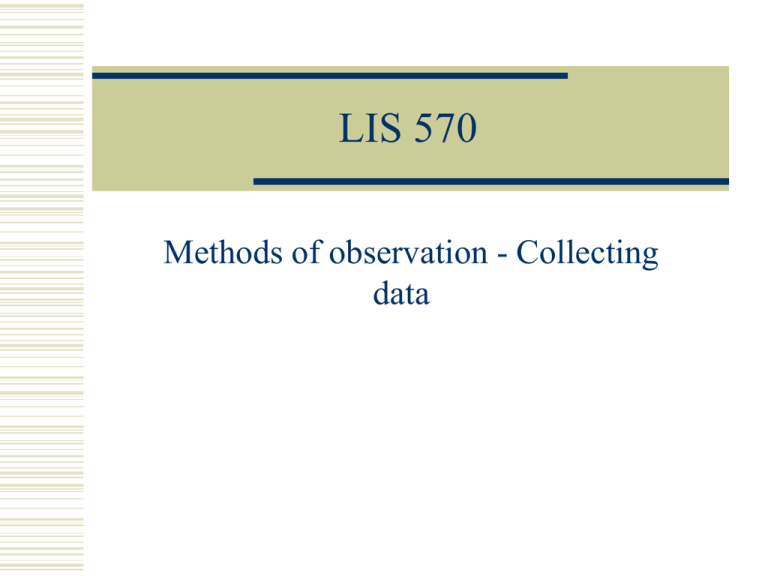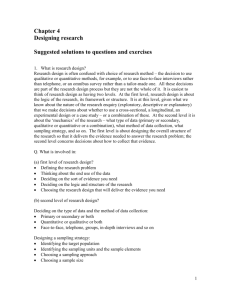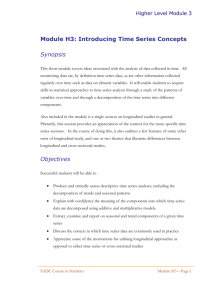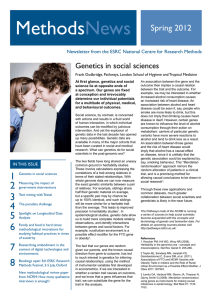PowerPoint
advertisement

LIS 570 Methods of observation - Collecting data Summary Definition Criteria for selection Type of research Explanatory Descriptive Common designs Asking questions Research Design: Definition Framework which guides the collection of data Blueprint for the study Goal - to select the strongest design for the type of research Two major types of research descriptive explanatory Choice of research design (Bouma) Depends on the hypothesis or research objective of the study Case study - What is happening? Longitudinal study - Has there been a change in A Comparison - Are A and B different? Longitudinal comparison - Are A and B different through time? Experiment - Is the difference between A and B due to a change in the independent variable? Case study Most primitive design of little use when trying to analyse causal processes would rely on plausible conjecture Collecting information from one group at one point in time Aim - description - what is going on? Is there a relationship between A and B? The longitudinal study Two or more case studies of the same group separated by an interval of time Measurement of a variable at both points of time Intervention cannot conclude a causal influence Time 1 Intervention Time 2 Comparison study Cross-sectional design Most common Collect measures from at least two groups of people at one point in time Compares the extent to which the two groups differ on the dependent variable Comparison Study Select variable related to the concept under study Devise a way to measure the variables Develop a data recording devise Measure the same variable in the same way in two or more groups at the same or nearly the same time A Are A and B different? Time 1 B Longitudinal comparison Quasi-panel design different groups of people are studied at the two points of time Can avoid problems of keeping track of people over time Problems can’t draw causal inferences difficulties with matching the samples at time 1 and time 2 Explanatory Research: Basic Requirements A relationship between the variables needs to be established All other reasons for the relationship must be able to be eliminated Strongest research design is an experimental design Classic Experimental Designs: Minimum Requirements Two groups Experimental group Control group Random Assignment of units of analysis to C and E groups Active intervention for the E group Purposefully changes the conditions of the Independent Variable (X) Synonyms Manipulation of the IV Treatment Measurement of Dependent Variable Y at the end of intervention for E and C groups Collecting data How the data will be collected observation in-depth interview content analysis Questionnaire Which questions to ask? Research problem indicators hunches about the link between variables Questionnaires Explanatory research Measures of the dependent variable Measures of the independent variable Measures of the test variable Background measures Descriptive research the phenomenon we are describing background characteristics Question content Behavior what people do Beliefs what people believe is true or false Attitudes what people think is desirable Attributes characteristics Wording questions (De Vaus, Babbie) Is the language simple? Can the question be shortened Is the question double-barrelled? Is the question leading? Is the question negative? Is the respondent likely to have the necessary knowledge? Will the words have the same meaning for everyone? Is there a prestige bias? Wording questions Is the question ambiguous? Do you need a direct of indirect question? Is the frame of reference for the question sufficiently clear? Does the question artificially create opinions? Is personal or impersonal wording preferable? Wording questions Is the question wording unnecessarily detailed or objectionable? Does the question have dangling alternatives? Is the question likely to produce a response set? Question types (De Vaus) Open and closed questions? Closed question formats Category rating scales Semantic differential formats Checklists Ranking formats Attitude choice Conclusion Simple case study What is happening? Longitudinal study Has there been a change in A Comparison Are A and B Different? Longitudinal comparison Are A and B different through time? Experiment Is the difference between A and B due to a change in the independent variable









